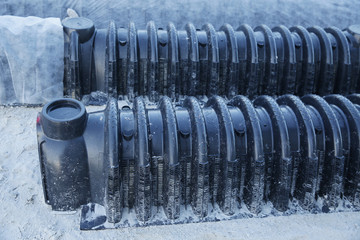Leach fields, an essential component of a home’s septic system, play a critical role in the final treatment and disposal of wastewater. Proper maintenance of your leach field can prevent significant problems, safeguarding both the environment and your property. This comprehensive guide outlines best practices for homeowners to maintain their septic leach fields effectively.
What is a Leach Field?
Before diving into maintenance practices, it’s important to know the answer to the question: what is a leach field? How does it function? A leach field, also known as a drain field, is a series of underground pipes connected to the septic tank. These pipes distribute the pre-treated wastewater over a large area, allowing it to percolate through the soil for final filtration. This process naturally removes harmful bacteria and nutrients, making the water safe to re-enter the groundwater system.
Regular Inspection and Pumping
Septic Tank Inspection
Regular inspections of your septic tank are crucial to prevent solids from overflowing into the leach field, which can clog the system. Experts recommend inspecting your tank at least once every three years and pumping it as necessary, typically every three to five years, depending on usage and household size.
Leach Field Area Inspection
Inspect the leach field area for any signs of system failure, such as soggy ground, foul odors, or unusually lush vegetation. These symptoms can indicate that wastewater is not being properly absorbed and treated.
Water Usage and Conservation
Efficient Water Use
Excessive water entering the septic system can overload the leach field, reducing its efficiency and lifespan. Implement water-saving fixtures and practices, such as high-efficiency toilets, showerheads, and washing machines. Also, spreading out water usage throughout the week can prevent sudden surges that stress the system.
Leak Repairs
Regularly check for and repair any leaks in your plumbing system to prevent unnecessary water from entering the septic system, which can lead to overloading of the leach field.
Landscaping and Surface Protection
Proper Landscaping
The area above the leach field should be covered with grass to prevent erosion and help with water absorption. Avoid planting trees or deep-rooted plants nearby, as their roots can damage the pipes and reduce the field’s effectiveness.
Surface Protection
Never drive or park vehicles in the leach field area, as this can compact the soil and damage the pipes. Structures such as decks, pools, or sheds should also not be built over this area to ensure unimpeded access for maintenance and to avoid soil compaction.
Chemicals and Waste Disposal
Household Chemicals
Limit the use of heavy chemicals and cleaners that can be flushed down your drains. These substances can kill the beneficial bacteria in the septic system and contaminate the groundwater. Opt for septic-safe products whenever possible.
Solid Waste
Be mindful of what goes down your drains. Non-biodegradable items, excessive food waste, grease, and certain paper products can clog your system. Use trash bins for solid waste disposal instead of toilets and sinks.
Professional Maintenance and Repairs
While regular homeowner maintenance is essential, certain aspects of septic system care require professional attention. If you notice any signs of leach field failure or if routine inspections suggest potential issues, contact a septic service professional immediately. They can provide specialized services such as jetting (cleaning the pipes with high-pressure water) or adding bacteria additives to help break down waste, though the latter should be done under professional guidance.
Education and Awareness
Understanding how your septic system and leach fieldwork is fundamental to maintaining it properly. Educate all household members about the importance of water conservation and what should not be disposed of down the drain. Awareness can significantly impact the longevity and effectiveness of your septic system.

What is the purpose of a leach field in a septic system?
A leach field, also known as a drain field, is an integral component of a septic system that handles the final treatment and disposal of wastewater from your home. After solids settle in the septic tank, the remaining wastewater flows into the leach field, where it is distributed through a series of perforated pipes into the soil. The soil acts as a natural filter, removing harmful bacteria, viruses, and nutrients from the wastewater before it safely re-enters the groundwater system. This process not only prevents contamination of water sources but also ensures that your property remains sanitary.
How often should my septic tank be inspected and pumped?
It is generally recommended that your septic tank be inspected at least once every three years by a professional, and pumped as needed, typically every three to five years. However, the frequency can vary based on several factors, including the size of your tank, the number of people living in your home, and your household’s overall water usage. Regular inspections can help catch potential issues early, preventing more significant problems with the leach field and ensuring the system’s efficiency and longevity.
Can I plant a garden over my leach field?
It is advisable to use caution when landscaping over your leach field. While grass is ideal for preventing erosion and assisting with water absorption, planting a garden, especially with deep-rooted plants or vegetables, is not recommended. Roots from larger plants or trees can clog and damage the perforated pipes in the leach field, leading to system failure. Additionally, bacteria and viruses present in the wastewater can pose a health risk to vegetables grown directly above the leach field.
Why is it important to conserve water with a septic system?
Water conservation is crucial in homes with septic systems because excessive water entering the system can overload the septic tank and leach field, leading to potential system failure. When too much water floods the system, it can push solids out of the tank into the leach field, causing blockages and preventing the soil from effectively treating the wastewater. Implementing water-saving practices and fixtures can help maintain the balance and efficiency of your septic system.
What should I avoid flushing or draining into my septic system?
To maintain the health and efficiency of your septic system, it’s essential to be mindful of what goes down your drains. Avoid flushing non-biodegradable items, such as feminine hygiene products, condoms, diapers, and wipes, as they can clog the system. Also, refrain from pouring grease, fats, and oils down the sink, as they can solidify and cause blockages. Household chemicals, such as paint, solvents, and high-strength cleaners, should also be used sparingly or disposed of properly, as they can disrupt the bacterial balance in the septic tank necessary for breaking down waste.
Conclusion
Maintaining your septic leach field is not just about preventing unpleasant backups or odors; it’s about protecting your home investment and the environment. By following these best practices, homeowners can ensure their septic system operates efficiently for years to come. Regular inspections, mindful water usage, appropriate landscaping, careful waste disposal, and professional maintenance are all key components of a healthy leach field. Remember, a little prevention goes a long way in avoiding costly repairs and ensuring the sustainability of your home’s wastewater treatment system.
ALSO READ : Fashion




I sincerely enjoyed what you’ve accomplished here. The sketch is fashionable, your written content chic, yet you appear to have developed some apprehension regarding what you aim to offer thereafter. Certainly, I shall return more frequently, just as I have been doing almost constantly, should you uphold this upswing.
I sincerely admired what you’ve produced here. The sketch is elegant, your written content chic, yet you appear to have developed some anxiety regarding what you aim to offer thereafter. Certainly, I shall return more frequently, just as I have been doing almost constantly, should you uphold this incline.
Pingback: Why Stay Away From The Book Of Enoch: Top 5 Reasons? -
Your article helped me a lot, is there any more related content? Thanks!
Lovely just what I was looking for.Thanks to the author for taking his time on this one.
purple pharmacy mexico price list
http://cmqpharma.com/# mexican online pharmacies prescription drugs
mexico drug stores pharmacies
mexican border pharmacies shipping to usa: mexican pharmacy – mexican pharmaceuticals online
pharmacies in mexico that ship to usa: pharmacies in mexico that ship to usa – п»їbest mexican online pharmacies
https://canadapharmast.online/# trustworthy canadian pharmacy
best mail order pharmacy canada pharmacies in canada that ship to the us canadian pharmacy king reviews
indian pharmacy paypal: indian pharmacy paypal – pharmacy website india
mexican rx online: mexico pharmacies prescription drugs – mexican mail order pharmacies
pharmacies in canada that ship to the us: canada pharmacy online – canadian pharmacy 1 internet online drugstore
vipps approved canadian online pharmacy cheap canadian pharmacy canadian discount pharmacy
purple pharmacy mexico price list: buying from online mexican pharmacy – reputable mexican pharmacies online
http://foruspharma.com/# mexico pharmacies prescription drugs
purple pharmacy mexico price list: medicine in mexico pharmacies – mexico drug stores pharmacies
indian pharmacy online: Online medicine home delivery – indian pharmacy online
reputable mexican pharmacies online buying from online mexican pharmacy best online pharmacies in mexico
cheapest online pharmacy india: india pharmacy mail order – pharmacy website india
https://indiapharmast.com/# indian pharmacy online
canadian pharmacy ltd: canada drugs online – is canadian pharmacy legit
mexican drugstore online: mexican pharmacy – buying prescription drugs in mexico
canadian pharmacy king reviews canadian pharmacy drugs online best online canadian pharmacy
medication from mexico pharmacy: mexico pharmacies prescription drugs – mexican pharmacy
amoxicillin buy online canada: amoxicillin canada price – buy cheap amoxicillin
https://ciprodelivery.pro/# buy cipro online canada
http://ciprodelivery.pro/# buy cipro online without prescription
https://ciprodelivery.pro/# cipro ciprofloxacin
https://doxycyclinedelivery.pro/# doxycycline where to get
http://paxloviddelivery.pro/# Paxlovid buy online
https://paxloviddelivery.pro/# Paxlovid buy online
https://amoxildelivery.pro/# where can i buy amoxicillin without prec
http://amoxildelivery.pro/# amoxicillin 500mg price
https://paxloviddelivery.pro/# buy paxlovid online
can you buy generic clomid price: how to get generic clomid price – how to buy clomid without a prescription